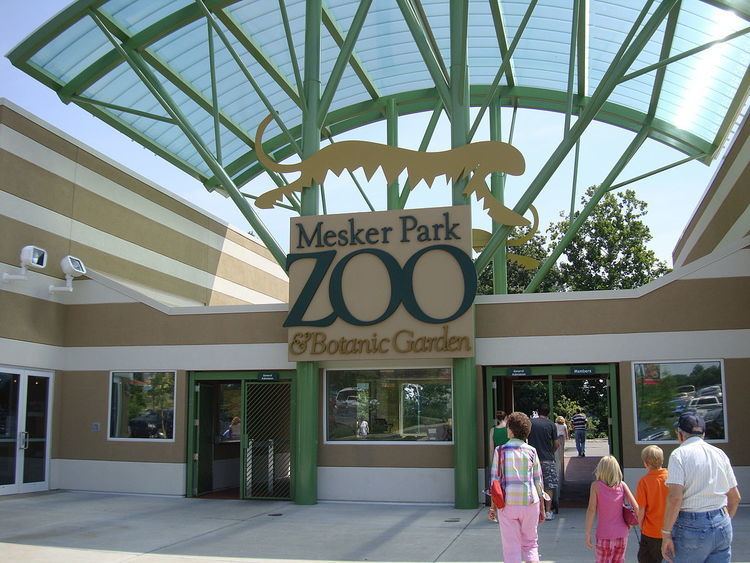Date opened 1928 No. of animals 700+ Memberships AZA | Land area 50 acres (20 ha) No. of species 200 | |
 | ||
Location Evansville, Indiana, USA | ||
Mesker park zoo evansville
The Mesker Park Zoo and Botanic Garden is a zoo that opened in 1928 in Evansville, Indiana. It is one of the oldest and largest zoos in the state. Set in a 50-acre (20 ha) park, the zoo features 200 species and more than 700 animals roaming freely in natural habitats surrounded by exotic plants, wildflowers, and trees.
Contents
- Mesker park zoo evansville
- History
- Exhibits
- Amazonia
- North America
- Tropic America
- Discovery Center
- Lemur Forest
- African Rift
- Kley Building
- Asia Australia
- Childrens Enchanted Forest
- Lake Victoria
- African Panorama
- Conservation
- References
The Mesker Park Zoo and Botanic Garden is accredited by the Association of Zoos and Aquariums.
History
The zoo was founded in 1928 by Gilmour Haynie and other business leaders. Karl Kae Knecht, a local cartoonist for the Evansville Courier & Press, helped popularize the idea of a zoo. It initially opened with two lion cubs, some antelope, and an elephant.
In 2008 the zoo finished a major expansion including the $15 million tropical rainforest exhibit and a new entry complex. The new exhibit was credited with drawing more than 38,000 visitors in its first month. One of two existing lakes in the zoo was filled in to make the exhibit, which added more than 150 animals to the zoo.
Exhibits
Mesker Park was one of the first zoos in the United States to use a moat system to display animals in more natural exhibits. The zoo's exhibits (counter-clockwise around the zoo from the entrance) include Amazonia, North America, Tropic America, Discovery Center, Lemur Forest, African Rift, the Kley building, Asia & Australia, Children's Enchanted Forest, and African Panorama.
Amazonia
Amazonia is a rainforest exhibit that opened in 2008. The exhibit added more than 150 animals to the zoo including jaguars, Baird's tapir, capybaras, keel-billed toucans, macaws, bats, iguanas, howler monkeys, squirrel monkeys, and yellow-spotted river turtles.
North America
North America includes a large gray wolf enclosure, as well as prairie dogs, bobcats, and bald eagles.
Tropic America
Tropic America includes reproductions of the South American Pantanal swamp and Lake Titicaca. Animals in this area include the rhea, llamas, and black swans.
Discovery Center
Discovery Center is an indoor exhibit that is home to Francois' langur, red pandas, cotton-top tamarin, binturong, clouded leopard, serval, northern pied hornbill, hyacinth macaw, and frogs.
Lemur Forest
Lemur Forest was opened in 1999 to house the zoo's lemurs.
African Rift
The African Rift exhibit includes reticulated giraffes, Grant's zebras, sitatunga, and white storks in a large open area.
Kley Building
The Kley Building houses a nocturnal exhibit, animals you would find in a mangrove swamp, a reptile exhibit including rhinoceros iguana and Aldabra tortoise, tropical birds, and the zoo's Indian rhinoceros. It was once home to the world's oldest living hippopotamus in captivity, Donna, who died at the age of 60 in 2012. Donna was euthanized on Wednesday, August 1, 2012, because of her failing health. Another notable former resident was Bunny, an Asian elephant, who left in 1999.
Asia & Australia
This area reproduces habitats for Asian and Australian animals. It includes the outdoor exhibits for the zoo's Indian rhinoceros, as well as kaziranga, Bactrian camels, sarus crane, barasingha, lions, tigers, Przewalski's horses, wallabys, and emus.
Children's Enchanted Forest
This exhibit is a children's petting zoo that was originally created in 1975, and has been renovated and renamed "Children's Enchanted Forest." This area still includes a "contact area," and is home to otters and colobus monkeys.
Lake Victoria
Lake Victoria is home to water birds and turtles. Visitors can walk all the way around this lake, or rent paddle boats to go out on the lake. This is the largest lake in the zoo, and is the feature around which the zoo was built.
African Panorama
African Panorama is a large open set of enclosures with overlooks for visitors. It is designed to look like the African savanna, and includes klipspringers, cheetahs, Abyssinian ground-hornbills, ostriches, and kudu.
Conservation
Mesker Park Zoo & Botanic Garden’s mission is to foster the preservation of the Earth’s diverse species and living systems through an active role in education and conservation. It actively participates with other accredited zoos for the responsive management of rare species.
The zoo has had some success in breeding the rare Francois' langur. The zoo received two females, Liang and Sai, in November 2003 from the San Diego Zoo. Each gave birth to a son in August 2006. The father came from the Cincinnati Zoo in December 2005. In February 2008 Liang gave birth to a female.
